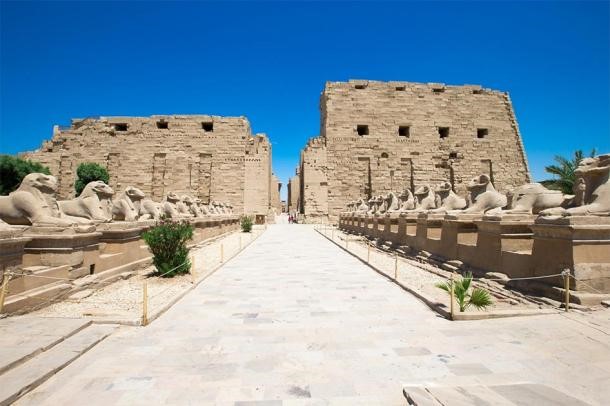
Luxor Temple is one of the most famous temple complexes in Egypt and was recognized for its religious importance when it was inscribed in UNESCO’s World Heritage List in 1979. Unlike other temples, which were dedicated to a cult god or deified version of a pharaoh, Luxor temple was dedicated to the rejuvenation of kingship. It also formed part of the Opet Festival, an annual event in which the reigning pharaoh would undergo a ritual marriage ceremony with the deity Amun.
The Luxor temple complex is situated on the east bank of the Nile River, in Luxor (ancient Thebes). It was constructed around 1400 BC, during the New Kingdom. Much of the temple complex was built by Amenhotep III, a pharaoh of the 18th Dynasty, who reigned during the first half of the 14th century BC. Amenhotep was a powerful ruler and Egypt prospered under his leadership. Luxor Temple is one of his greatest building projects.
Luxor Temple was also known by the ancient Egyptians as ipet resyt (which translates to mean ‘Southern Sanctuary’). This is meant to distinguish Luxor Temple from Karnak Temple, which is situated about 3 km (1.86 mi) to its north. The two temples were once connected by the Avenue of the Sphinxes, a processional road lined with sphinxes on each side.

The Great Temple of Amun at Karnak, Egypt. (Pakhnyushchyy / Adobe stock)
Although the construction of Luxor Temple began during Amenhotep’s reign, subsequent pharaohs added their own touches to the temple complex. Amenhotep’s successor, the enigmatic Akhenaten, for instance, built a sanctuary dedicated to the Sun god, Aten, next to Luxor Temple. The pharaoh who made the most impressive additions to Luxor Temple, however, was Ramesses II. He built the first pylon, which became the entrance to Luxor Temple.
After the conquest of Egypt by the Greeks, the chapel of Amun was rebuilt by Alexander the Great. Even the Roman emperor Hadrian built something at Luxor Temple. He is recorded to have constructed a small mudbrick shrine dedicated to Serapis. Later on, when the Roman Empire adopted Christianity, Christian churches were built around the temple. In fact, one of these churches was built inside the temple itself, in Ramesses’ courtyard. After Egypt was conquered by the Arabs, this particular church was turned into a mosque, which is still standing today. Luxor temple has been in almost continuous use as a place of worship for its 3,400-year existence.
Top image: Ancient columns at the Luxor Temple in Egypt. ( zevana / Adobe stock)






